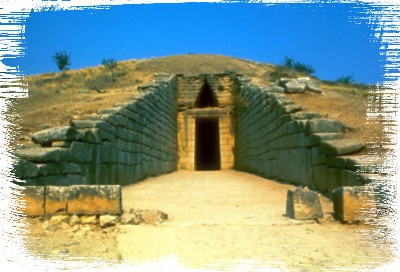

The
name of Mycenae is linked with what is perhaps the most important cycle of
Greek myths, as we know it from the epics of Homer and the works of the
great ancient tragedians. According to these traditions, Mycenae was
founded by Perseus, son of Zeus and Danae, whose descendants ruled the
area for many generations. The dynasty of Perseus was succeeded by the
Atreides family, founded by Atreus. The son of Atreus was Agamemnon, who
led Greeks
to glory in the Trojan War. On his return to Mycenae,
Agamemnon
was murdered by his wife Clytemnestra and her lover Aegisthus; later,
Agamemnon's children Orestes and Electra avenged their father by killing
Clytemnestra. According to many scholars, Mycenae was totally devastated
at á time which can identified with the reign of Tisamenus, son of
Orestes.
Much
of the mythological tradition about Mycenae was confirmed by the
excavations carried out there by the Greek Archaeological Association
(after 1841), Heinrich Schliemann (1876), and - in more recent times - C.
Toundas, Á. Wace, É. Papadimitriou, 0. Mylonas and Lord Taylour. The
hill of Mycenae (278 m.), high above the village of Fichtia, is made into
á natural stronghold by the deep ravines, which separate it from the
steep hills of Profitis Ilias and Sara. The first settlement here was in
Neolithic times, but the city was at the height of its power in the late
Helladic period (1600-1100 BC), which for that reason is known as the
Mycenean Period. In about 1100 BC, the city was totally destroyed, after
which the acropolis came under the control of Argos. In 468 BC, the
Argives demolished the walls of Mycenae. In the third century BC, they
founded á citadel there, but this seems to have been declined and
abandoned during the Roman era.
At its zenith, Mycenae was the center of the Greek world. Today, extensive ruins have survived of its imposing acropolis, surrounded by superb 1 'Cyclopean' walls rising to 12 m. in height and pierced by the Lion Gate. Inside the acropolis are some of the religious buildings of the city, the king's palace and storehouses, while traces of the water supply system can also be seen. Of particular interest are the two circular grave precincts, containing royal burials, which yielded many precious finds. Outside the circuit of walls are á number of elaborate tholos (beehive) tombs, notably those called the 'Treasury of Atreus', the 'Tomb of Clytemnestra', the 'Tomb of Aegisthus' and the 'Lion Tomb'. The finds from Mycenae, which are of incomparable archaeological value, are housed in the National Archaeological Museum in Athens and in Nafplio Museum.